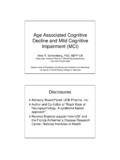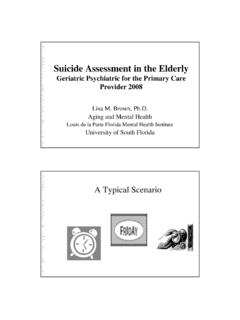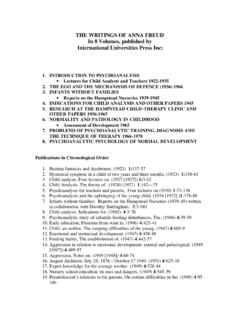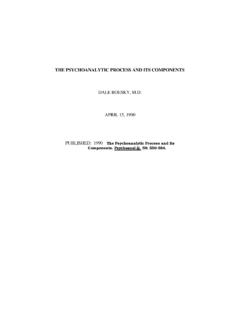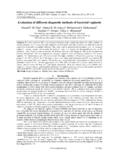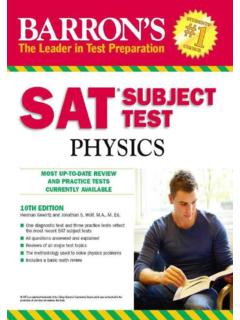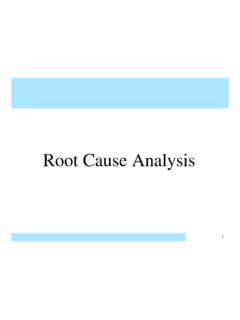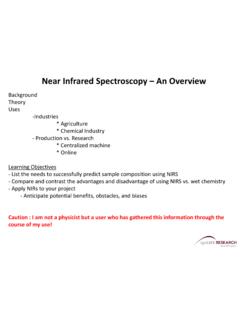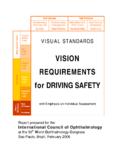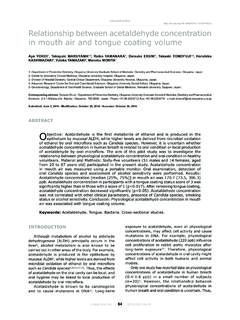Transcription of Computerized Neuropsychological Assessment: …
1 1 Computerized Neuropsychological assessment : The Good, the Bad, and the UglyMike R. Schoenberg, , ABPP-CNDepartment of NeurologyUniversity Hospitals Case Medical CenterDisclosuresNone2 ObjectivesNeuropsychological EvaluationBases of assessment Traditional Neuropsychological assessment Measures Benefits/Strengths (the good) Problems/Weakness (the bad and ugly) Computerized Cognitive assessment Measures Benefits (The good) Problems (The bad and ugly)ConclusionsFuture DirectionsNeuropsychological Evaluation: FundamentalsStudy of Brain-Behavior Relationships Identifies presence (or absence) of Neuropsychological DeficitsAssumptions for Evaluation Brain dysfunction affects behavior Behavior changes can be associated with particular brain processes/areas/neurological syndromes assessment can be reliable assessment can be valid assessment affects diagnosis/treatment3 Neuropsychological Evaluation.
2 TraditionalAssessment versus Evaluation AssessmentCollection of historical dataCollection of cognitive dataCollection of mood data Evaluation Interpretation of data for diagnosis/treatment planningPurpose of AssessmentScreen for presence/absence of potential problem or change Is performance above or below threshold to identify possible problem?Common example is MMSE or Clock Drawing task Screening data, in and of itself, typically not diagnostic nor used for treatment planning Diagnosis of problem (etiology) and plan treatment Is data suggestive of known syndromes/diagnostic entities?
3 Interpretation of data for diagnosis/treatment planning 4 Neuropsychological Evaluation: assessment MethodsHistorical information Referral question(s) Presenting problems Historical informationOther laboratory testsComorbid conditionsOther historical dataClinical InterviewBehavioral observations Neurobehavioral tests/sensory/perceptual/cranial test administration Paper and pencil based cognitive tests Computer assisted testsPsychological test administrationAssessment of effort/Task engagementAssessment: The BasicsAssessment measures must be: Reliable Valid Efficient Sensitive (and specific)5 assessment : The BasicsReliability: Reliability typically refers to consistency in measuring a construct A test is only as valid as it is reliable Reliability includes internal consistency, test-retest reliability, alternate forms, consistent is how consistent items within a test are to measuring the constructTest-retest reliability how consistent across time.
4 Assumes construct does not change over : The BasicsValidity Extent test measures what it intends to measureCriterion Related validity Predictive (criterion) ValidityHigh score predict behavior/deficit (dementia) Concurrent validity Does shorter test measure same construct as validated longer test?Construct related validity Convergent/discriminant validitydo scores differ between groups with syndromes/dx in which test scores should theoretically differ Ecological validity Extent test predicts a real world behavior or problem thought to be associated with construct ( , good driving)
5 6 Sources of assessment ErrorMeasurement error assessment a picture in time Variation in CNS pathology Test not perfectly validSome error in tests Sampling errorSelection of tests and test items Scoring/Administration errorsIntra-rater reliability Inter-rater reliability Patient variablesTask engagement/motivation to perform wellEducational/occupational/cultural/la nguage/age factorsTest score = syndrome + measurement error + premorbid ability + drugs + effort + practiceDiagnostic CharacteristicsHit RateNPPPPPTestNOTestYES(c) False +(a) True +(d) True (b) False SPECD isease: NOSENSD isease: YESS ensitivity: a/[a + b].
6 It s there, and you see itSpecificity: d/[c + d]. It s not there, and you don t see itPositive Predictive Value: a/[a+c]. Your test says it s there, and it isNegative Predictive Value: d/[b+d]. Your test says it s not there, and it s not7 Neuropsychological EvaluationImportant shift in Neuropsychological assessment NOT can a cognitive test discriminate abnormal from healthy? Rather, can cognitive test/battery discriminate subtypes of diseases or phases of single disease. MMSE is highly sensitive, not specificThat is, if you score low on a test, suggestive something is wrong, but don t know what.
7 Diagnostic Characteristics dependent upon prevalence of disorderDiagnostic CharacteristicsHit Rate7624 TestNOTestYES14 (c)10 (a)75 (d)1 (b)89 Disease: NO11 Disease: YESS ensitivity (SENS): a/[a + b] = 91%Specificity (SPEC): d/[c + d] = 84%Positive Predictive Value (PPV): a/[a+c] = 42%Negative Predictive Value (PPV): d/[b+d] = 99%Hit Rate (HR) = 85%N = 100. Prevalence rate = 11%8 Diagnostic CharacteristicsHit Rate4454 TestNOTestYES8 (c)46 (a)42 (d)4 (b)50 Disease: NO50 Disease: YESS ensitivity: a/[a + b] =92%Specificity: d/[c + d] =84%N = 100. Prevalence rate = 50%PPV: a/[a+c] = 85%NPV: d/[b+d].
8 95%Hite Rate = 90 %Variables that effect diagnostic test characteristicsPrevalence rate affects PPV and NPV. Screening for a syndrome better with higher prevalence ratePositive Predictive Value (power) of test increases with higher prevalenceNeed to balance adverse affect of making false positive error versus a false negative error Screening ideal when consequence of false positive is low while consequence of making a false negative error is bad9 Brain Function OrganizationOutputOrganizationVerbal SkillsNon-verbal skills Learning and memoryAttention and concentrationSensesBaker GA.
9 Personal Communication, 2008 Neuropsychological Evaluation: Diagnostic assessment MeasuresMeasurement of cognitive constructs General Cognitive Ability (IQ) Achievement (academic development) Processing Speed/psychomotor speed Attention/Concentration Memory Language Visuoperceptual/Visuoconstructional Executive functions(problem solving, insight, judgment, etc.)Psychological Function10 Traditional NeuropsychologyBattery: DiagnosisComplex figure tasks, block design tasksVisuoperceptual/constructionIntelli gence Test ( , Wechsler Adult Intelligence tests)Achievement Tests General Cognitive (IQ)MMPI, Beck Depression InventoryMoodBoston Diagnostic Aphasia ExamVerbal Fluency Tests (semantic and phonemic)Token TestLanguageReceptive, Expressive, &repetitionWechsler Memory ScalesAuditory Verbal Learning TasksRey-Osterreith Complex Figure memoryLearning & MemoryImmediate (short-term)Delayed (long-term)Trail Making Test A & BCoding Tasks ( , symbol digit substitution)
10 Letter-number sequencing (working memory)Stroop color-word tasks (inhibition/interference)Wisconsin Card Sorting TestAttention/Executive FunctionFinger Tapping, Grooved Pegboard,Continuous Performance Tasks (reaction time)Psychomotor SpeedTESTSDOMAINSS tandard Neuropsychological Battery:The GoodEmpirical support for use of Neuropsychological tests to identify brain dysfunction Test Measures are ReliableInter-rater reliabilityIntra-rater reliabilityTest Retest (some better than others)Internal reliability Test Measures have validityCriterion Validity - Associated with known brain damage Poor validity for some known lesions ( , frontal)

